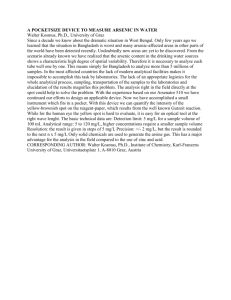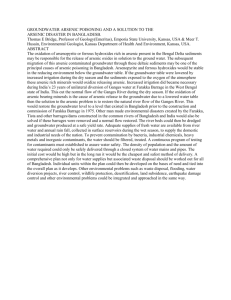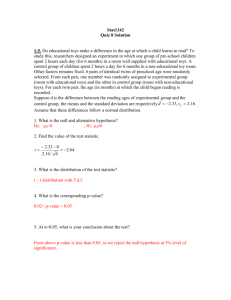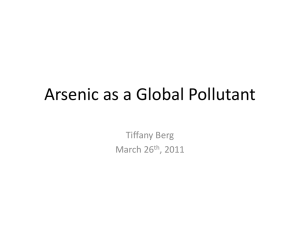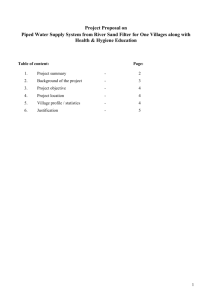Arsenic Removal Systems
advertisement
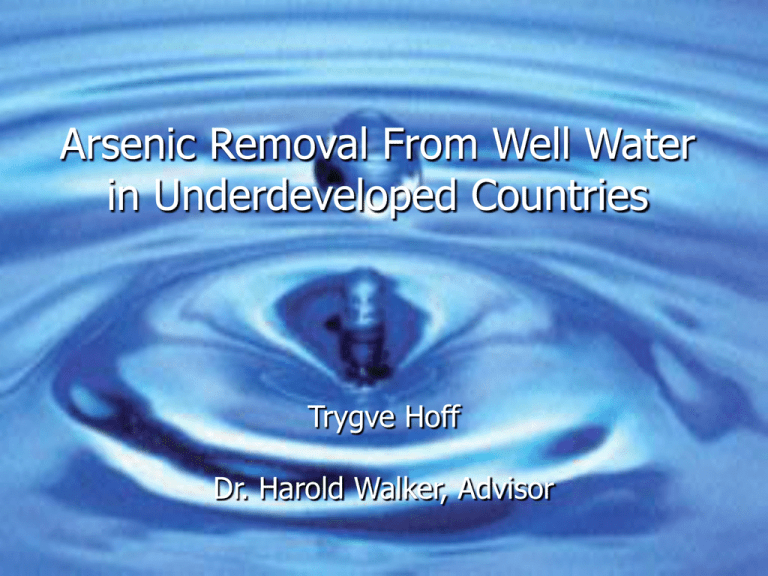
Arsenic Removal From Well Water in Underdeveloped Countries Trygve Hoff Dr. Harold Walker, Advisor Introduction • Arsenic contamination is a growing problem throughout the world •Argentina, Chile, China, India, Mexico, United States, Vietnam, Thailand and Bangladesh •Worst cases in Bangladesh and West Bengal regions Bangladesh Epidemic • Problem originated in the 1970s – UNICEF program to provide “safe” water – Arsenic wasn’t a known pollutant at the time – Saved thousands of lives from microbial pathogens, but … • 35-77 Million citizens at risk of arsenic poisoning (Out of a pop. of 125 Million) Bangladesh Epidemic • Tube well options: – Shallow Well – Deep Well • Deep Concerns – Renewability – Contamination from drilling? Construction Cost: $1000 Renewable: ?? As Contamination: No Construction Cost: $100 Renewable: Yes As Contamination: Yes 3m clay [As] 100m aquifer of gray sand Shallow Aquifer Clay Layer Deep Aquifer Southern Bangladesh 40m aquitard marine clay Deep Sandy Aquifer Bangladesh Epidemic • Arsenic Source: Geological – Rock, Clay, Peat and Sand potential sources – Increased [As] due to desorption from iron oxides • Change in pH, oxidation/reductions, and competing anions • Excessive irrigation pumping in dry season with carbon-caused mobilization Bangladesh Epidemic • The World Health Organization has set a guideline value of 0.01mg/l or 10 ppb – Bangladesh wells range from 0 to 1660 ppb Bangladesh Well Arsenic Contamination Dangerous (50+ppb) 25% Safe (0-10ppb) 58% Questionable (10-50ppb) 17% Health Risks • Arsenic poisoning appears after 10 years of consumption as arsenicosis – Can lead to: • Keratosis • Gangrene • Skin Cancer • Kidney Cancer • Bladder Cancer • Lung Cancer Health Risks • 10 year old children • are developing the arsenicosis Cancers appear after 20 years – Huge epidemic expected in the near future Health Risks • Treatments are limited – Consumption of only arsenic free water – Zinc, Selenium, and Vitamin A for repair of the skin – Chelation therapy • Not proven to help patients Research Goal • To find a temporary process that satisfies these objectives: 1. Effectively removes [As] to a potable level – Less than 10 ppb 2. Is economically feasible in undeveloped situations – Bangladesh Average Per Capita Income is $450 3. Requires minimal technological understanding Experimental Details • Three methods were used to treat the samples: 1. The STAR method – FeCl3 mixed into sample, poured through sand filter 2. The 3-Kalshi method – Sample poured through sand, iron filings, and sand 3. Granular Ferric Hydroxide Column STAR Setup Ferric Chloride Packet Sand Filter Water 3-Kalshi Setup Contaminated Water Coarse Sand Iron Shavings Coarse Sand Fine Sand Wood Charcoal—Not Used Fine Sand Collected Water GFH Column(s) Contaminated Water Treated Water Results • The GFH column performed sub par – Possibly due to: • Channeling of the media • Inadequate contact time • Media grains too large—Insufficient surface area and sorption sites Results • The GFH removed just over 80% [As] Arsenic Concentration GFH Method Arsenic Remaining (ppb) GFH Arsenic WHO Guideline 350 300 267 250 202 200 163 150 299 269 291 174 126 100 50 10 0 0 10 200 400 600 800 Volume Treated (ml) 1000 1200 1400 Results • STAR and 3-Kalshi methods both successfully removed the arsenic Arsenic Concentration 3-Kalshi and STAR methods 3-Kalshi STAR Detection Limit WHO Guideline Arsenic Concentration (ppb) 20 15 10 10 8 5 5 0 2 0.5 0 10 9 6 4 0.1 100 0.0 200 0.0 300 0.0 400 Volume Treated (ml) 3 500 2 600 Economic Analysis • Average income is $450 – Bangladesh is ranked 176th of 271 countries • Average Family size of 6 people • Consumption assumed to be 50 liters/day/person – Arsenic poisoning only through consumption – Only treat drinking and cooking water Economic Analysis • STAR: Packets available for $4/family/year • 3-Kalshi: Iron available for$4.50/family/year – Iron fines available at $30/ton – 3 kg shavings for ~240 liters • GFH: Initial cost of $7.00 for two columns, materials $2.00/family/year afterward Ease of Use • STAR: Simple – Drop packet in, pour through sand filter – Collect clean water • 3-Kalshi: Simple – Pour water into top bucket – Collect clean water • GFH: Very difficult – Requires technical training for a family member – Pump necessary for correct flow rate and pressure – Need a field test kit to determine when breakthrough has been reached Conclusion • The STAR method is most efficient and cheapest, and is easiest to use • 3-Kalshi method is plausible, though doesn’t remove as much [As] • GFH is a good method, but best used in neighborhoods that have a treatment plant and technicians • Education of the population is KEY



